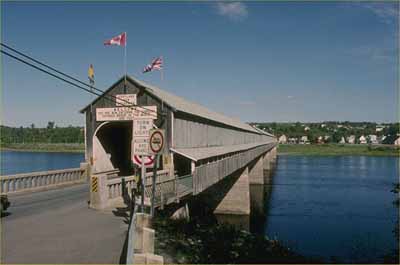Hartland Covered Bridge National Historic Site of Canada
Hartland, New Brunswick

Entrance
© Parks Canada Agency /Agence Parcs Canada, 1987.
Address :
Route 105, south east side of bridge, Hartland, New Brunswick
Recognition Statute:
Historic Sites and Monuments Act (R.S.C., 1985, c. H-4)
Designation Date:
1977-11-17
Dates:
-
1901 to 1901
(Construction)
-
1922 to 1922
(Additional alteration)
-
1901 to 1901
(Addition)
-
1940 to 1940
(Other addition)
Other Name(s):
-
Hartland Covered Bridge
(Designation Name)
Research Report Number:
Inscriptions Committee January 2024
Plaque(s)
Approved Inscription: New Brunswick
In Canada, covered bridges were built mostly in the Maritimes and Quebec, their wooden trusses enclosed to prevent rot. This outstanding example uses the widely adopted Howe truss system that incorporates iron tension rods for additional strength. Originally constructed uncovered, it opened in 1901, but a spring ice jam washed out two spans in 1920. By early 1922 the bridge was repaired and fully covered, with a walkway added in the 1940s. Spanning 390.75 metres (1282 feet), the structure claims the title of the longest covered bridge in the world and is an icon of New Brunswick’s built heritage.
Description of Historic Place
A striking feature in the New Brunswick landscape is the Hartland Covered Bridge, the largest of its kind in the world. Its massive concrete piers support a long, enclosed wooden bridge, held up by Howe trusses. The bridge offers protected crossing of the Saint John River at the Village of Hartland. The designation refers to the bridge structure and cladding on its piers.
Heritage Value
Hartland Covered Bridge was designated a national historic site of Canada because this structure is the longest covered bridge extant in the world.
The heritage value of this site resides in its design and physical fabric. The structure, 390.75 metres long, is believed to be by far the longest covered bridge extant in the world. Covered bridges date from the first decade of the 19th century when North American buildings began using wooden trusses for long spans and covered them to prevent the truss joins from rotting. After 1840 the Howe truss, which introduced iron tension rods into the truss work, was widely adopted and New Brunswick erected numerous bridges using this technique, among them this one, built in 1921 with a walkway added in 1943.
Source: Historic Sites and Monuments Board of Canada, Minutes, November 1977 and November 1979.
Character-Defining Elements
Aspects of this site which contribute to its heritage values include the features of a long covered bridge, namely its: construction design utilizing the Howe truss, in combination with wood framing, vertical weatherboarding and gabled roof, concrete piers and abutments, appended pedestrian walkway, wood shingle arched openings at either end and openings along its length, electrical lighting, and, relationship with the river, roads and shoreline.